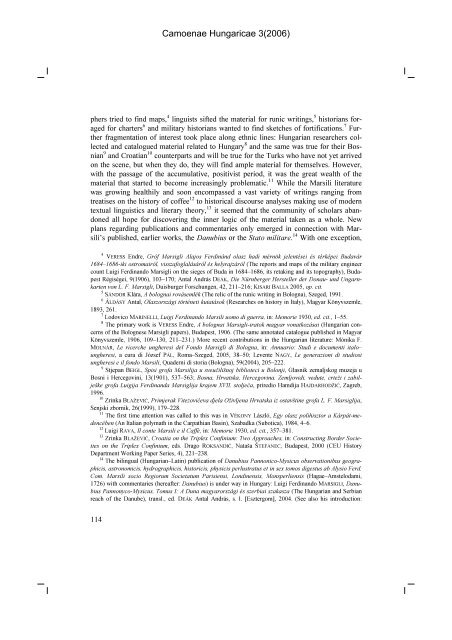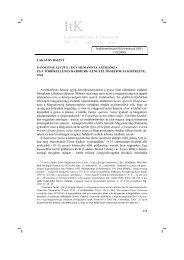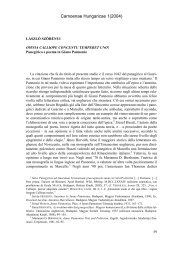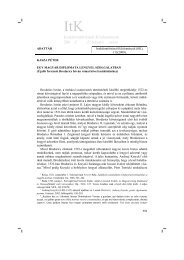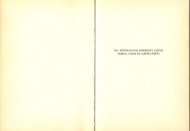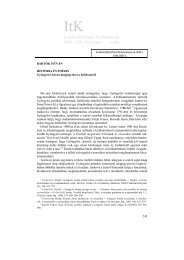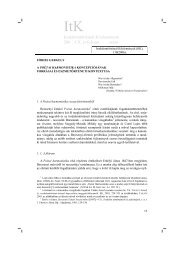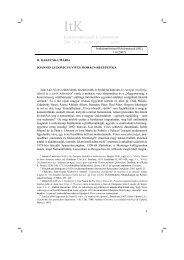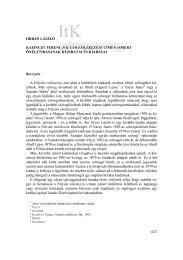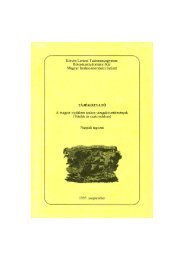Camoenae Hungaricae 3(2006) - Irodalomtörténeti Közlemények
Camoenae Hungaricae 3(2006) - Irodalomtörténeti Közlemények
Camoenae Hungaricae 3(2006) - Irodalomtörténeti Közlemények
Create successful ePaper yourself
Turn your PDF publications into a flip-book with our unique Google optimized e-Paper software.
phers tried to find maps, 4 linguists sifted the material for runic writings, 5 historians foraged<br />
for charters 6 and military historians wanted to find sketches of fortifications. 7 Further<br />
fragmentation of interest took place along ethnic lines: Hungarian researchers collected<br />
and catalogued material related to Hungary 8 and the same was true for their Bosnian<br />
9 and Croatian 10 counterparts and will be true for the Turks who have not yet arrived<br />
on the scene, but when they do, they will find ample material for themselves. However,<br />
with the passage of the accumulative, positivist period, it was the great wealth of the<br />
material that started to become increasingly problematic. 11 While the Marsili literature<br />
was growing healthily and soon encompassed a vast variety of writings ranging from<br />
treatises on the history of coffee 12 to historical discourse analyses making use of modern<br />
textual linguistics and literary theory, 13 it seemed that the community of scholars abandoned<br />
all hope for discovering the inner logic of the material taken as a whole. New<br />
plans regarding publications and commentaries only emerged in connection with Marsili’s<br />
published, earlier works, the Danubius or the Stato militare. 14 With one exception,<br />
04<br />
VERESS Endre, Gróf Marsigli Alajos Ferdinánd olasz hadi mérnök jelentései és térképei Budavár<br />
1684–1686-iki ostromairól, visszafoglalásáról és helyrajzáról (The reports and maps of the military engineer<br />
count Luigi Ferdinando Marsigli on the sieges of Buda in 1684–1686, its retaking and its topography), Budapest<br />
Régiségei, 9(1906), 103–170; Antal András DEÁK, Die Nürnberger Hersteller der Donau- und Ungarnkarten<br />
von L. F. Marsigli, Duisburger Forschungen, 42, 211–216; KISARI BALLA 2005, op. cit.<br />
05<br />
SÁNDOR Klára, A bolognai rovásemlék (The relic of the runic writing in Bologna), Szeged, 1991.<br />
06<br />
ÁLDÁSY Antal, Olaszországi történeti kutatások (Researches on history in Italy), Magyar Könyvszemle,<br />
1893, 261.<br />
07<br />
Lodovico MARINELLI, Luigi Ferdinando Marsili uomo di guerra, in: Memorie 1930, ed. cit., 1–55.<br />
08<br />
The primary work is VERESS Endre, A bolognai Marsigli-iratok magyar vonatkozásai (Hungarian concerns<br />
of the Bolognese Marsigli papers), Budapest, 1906. (The same annotated catalogue published in Magyar<br />
Könyvszemle, 1906, 109–130, 211–231.) More recent contributions in the Hungarian literature: Mónika F.<br />
MOLNÁR, Le ricerche ungheresi del Fondo Marsigli di Bologna, in: Annuario: Studi e documenti italo–<br />
ungheresi, a cura di József PÁL, Roma–Szeged, 2005, 38–50; Levente NAGY, Le generazioni di studiosi<br />
ungheresi e il fondo Marsili, Quaderni di storia (Bologna), 59(2004), 205–222.<br />
09<br />
Stjepan BEIGL, Spisi grofa Marsilija u sveučilišnoj biblioteci u Bolonji, Glasnik zemaljskog muzeja u<br />
Bosni i Hercegovini, 13(1901), 537–563; Bosna, Hrvatska, Hercegovina. Zemljovidi, vedute, crteži i zabilješke<br />
grofa Luigija Ferdinanda Marsiglija krajem XVII. stoljeća, priredio Hamdija HAJDARHODŽIĆ, Zagreb,<br />
1996.<br />
10<br />
Zrinka BLAŽEVIĆ, Primjerak Vitezovićeva djela Oživljena Hrvatska iz ostavštine grofa L. F. Marsiglija,<br />
Senjski zbornik, 26(1999), 179–228.<br />
11<br />
The first time attention was called to this was in VÉKONY László, Egy olasz polihisztor a Kárpát-medencében<br />
(An Italian polymath in the Carpathian Basin), Szabadka (Subotica), 1984, 4–6.<br />
12<br />
Luigi RAVA, Il conte Marsili e il Caffè, in: Memorie 1930, ed. cit., 357–381.<br />
13<br />
Zrinka BLAŽEVIĆ, Croatia on the Triplex Confinium: Two Approaches, in: Constructing Border Societies<br />
on the Triplex Confinium, eds. Drago ROKSANDIĆ, Nataša ŠTEFANEC, Budapest, 2000 (CEU History<br />
Department Working Paper Series, 4), 221–238.<br />
14<br />
The bilingual (Hungarian–Latin) publication of Danubius Pannonico-Mysicus observationibus geographicis,<br />
astronomicis, hydrographicis, historicis, physicis perlustratus et in sex tomos digestus ab Alysio Ferd.<br />
Com. Marsili socio Regiorum Societatum Parisiensi, Londinensis, Monsperliensis (Hagae–Amstelodami,<br />
1726) with commentaries (hereafter: Danubius) is under way in Hungary: Luigi Ferdinando MARSIGLI, Danubius<br />
Pannonyco-Mysicus, Tomus I: A Duna magyarországi és szerbiai szakasza (The Hungarian and Serbian<br />
reach of the Danube), transl., ed. DEÁK Antal András, s. l. [Esztergom], 2004. (See also his introduction:<br />
114<br />
<strong>Camoenae</strong> <strong>Hungaricae</strong> 3(<strong>2006</strong>)


